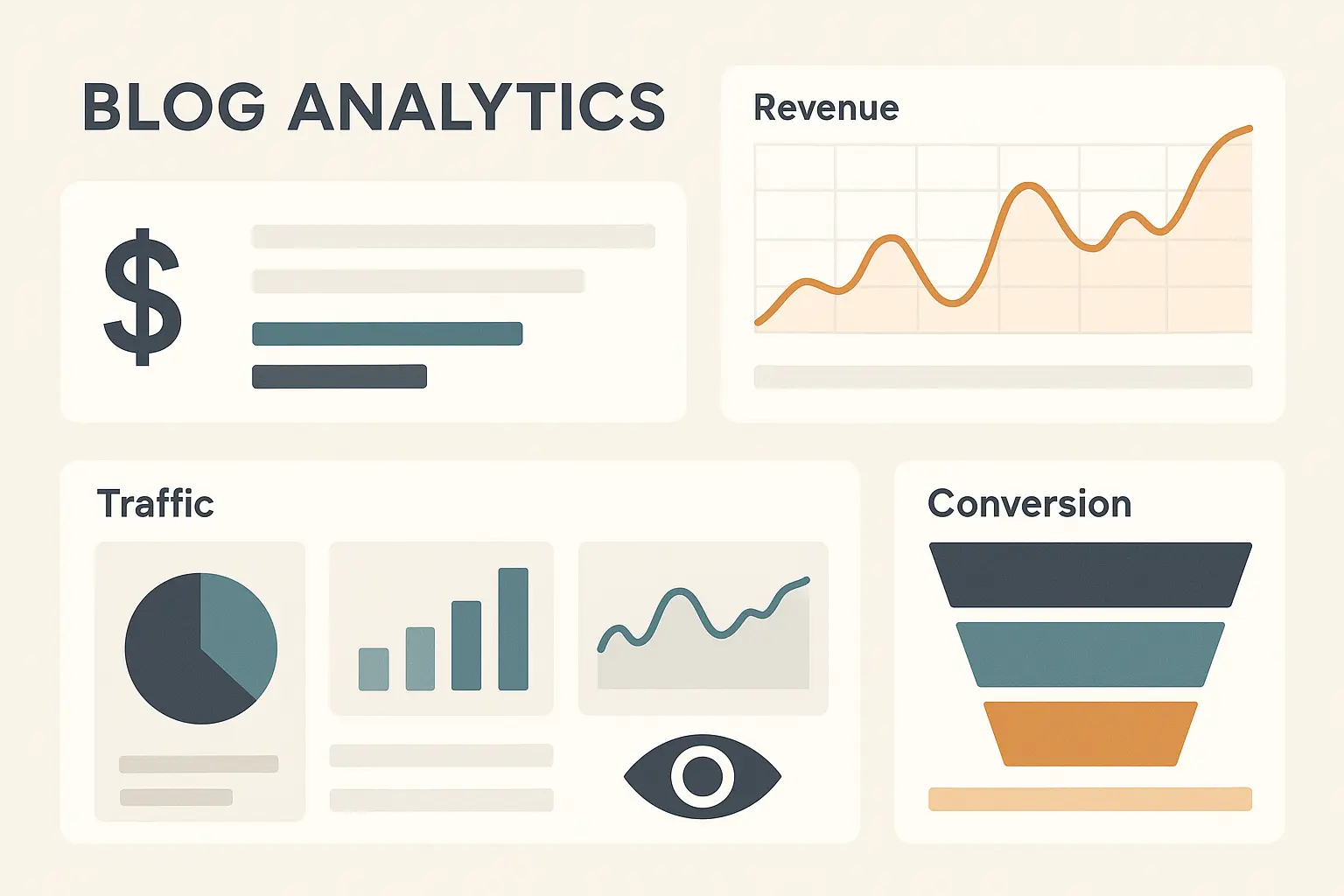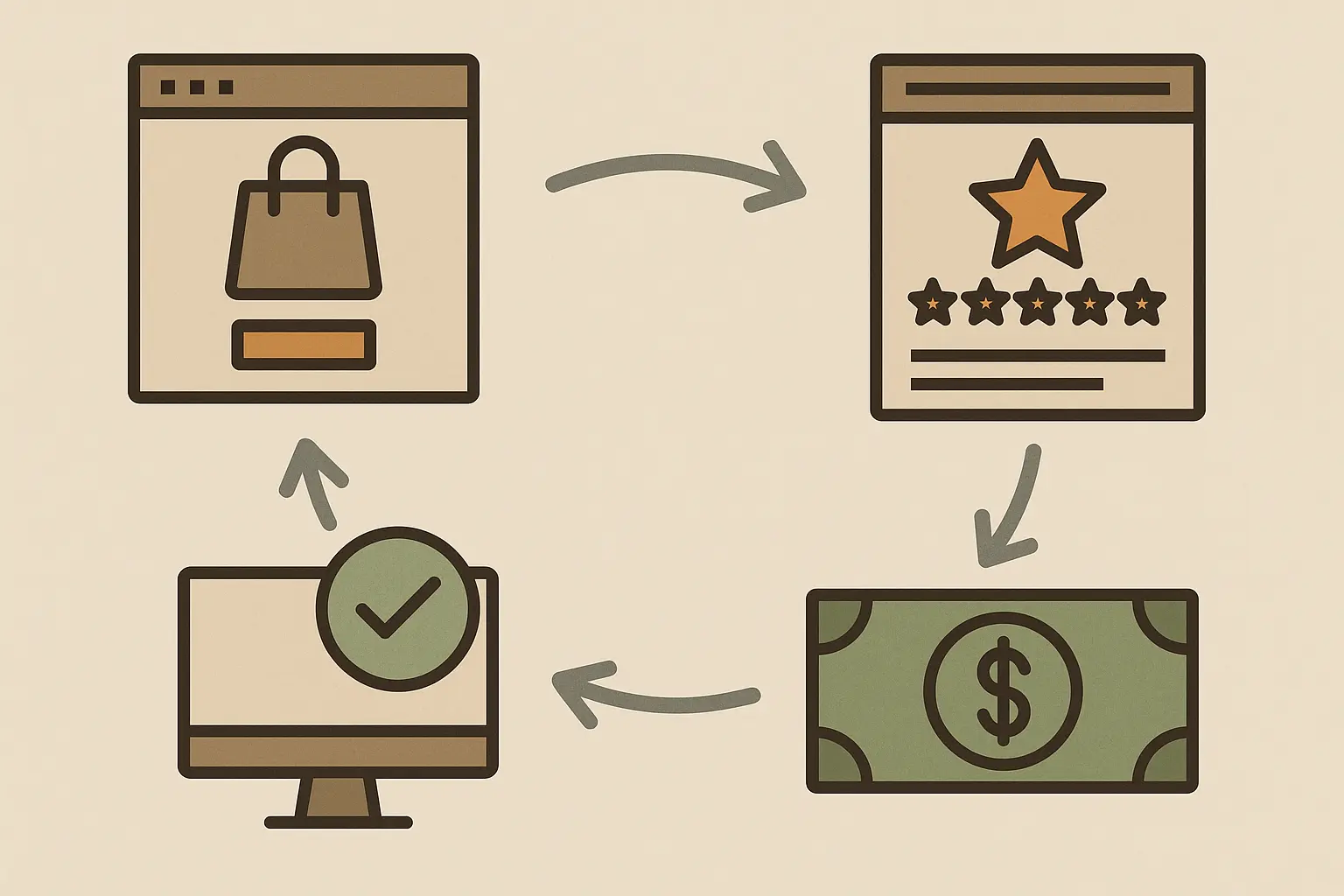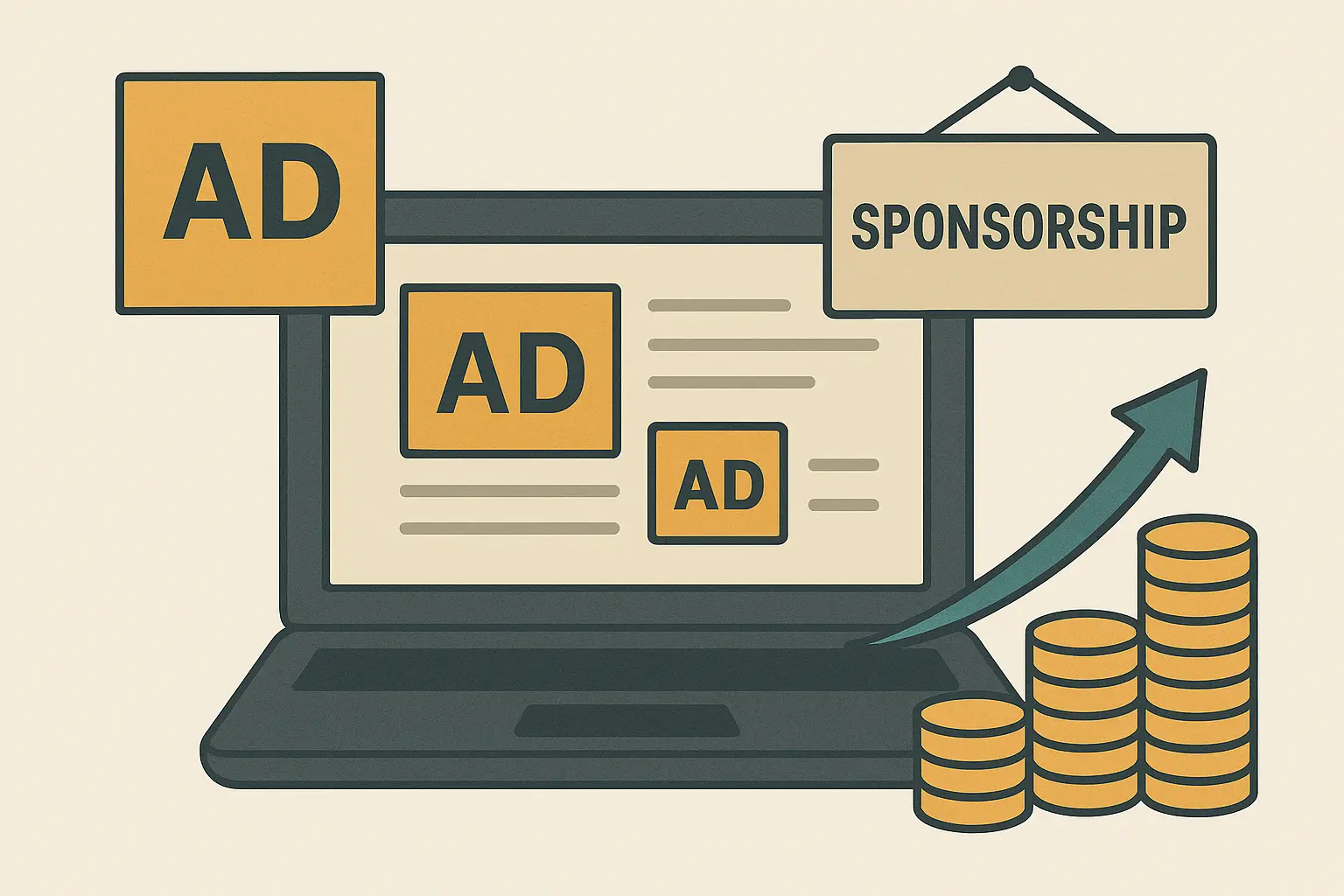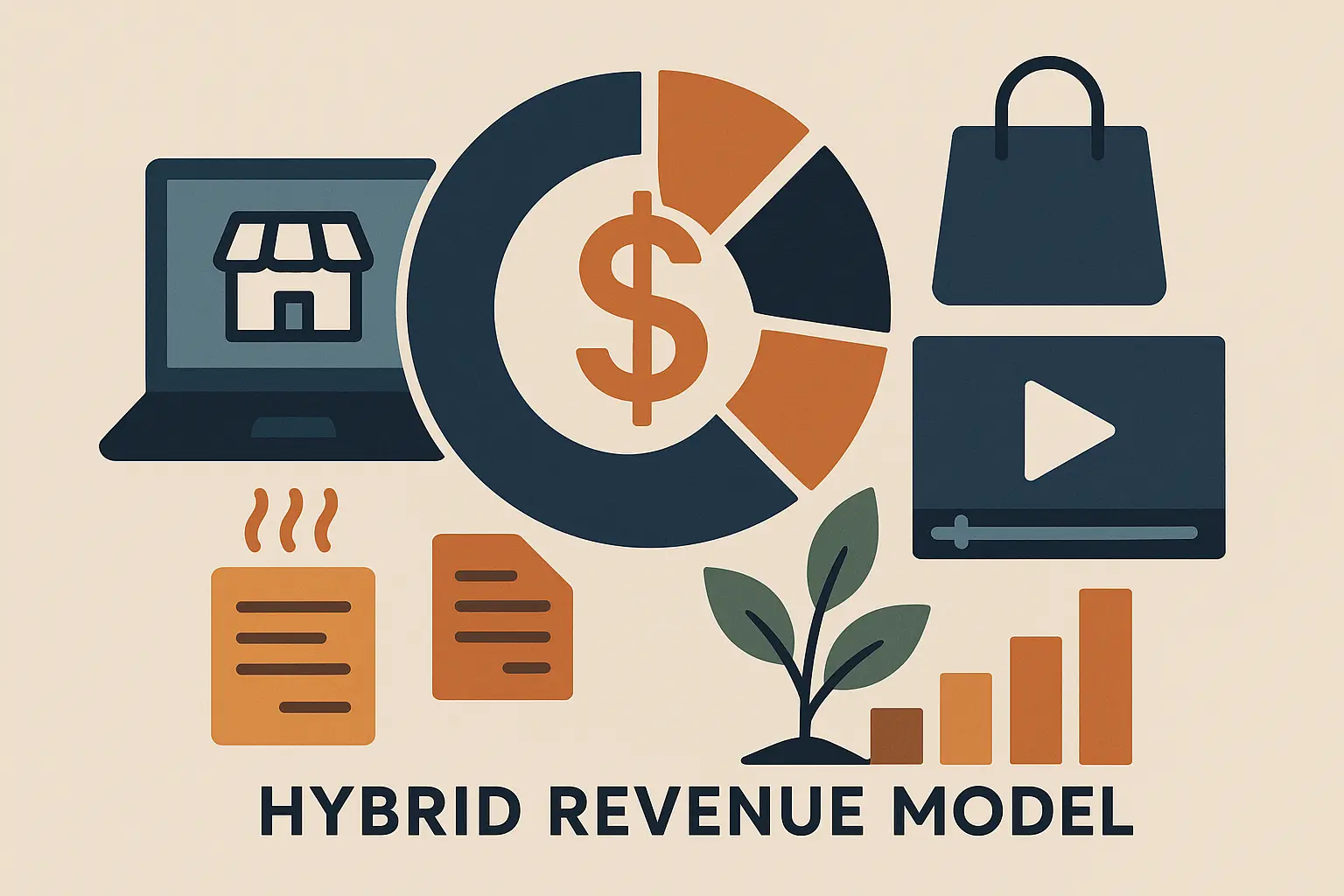I’ll be honest – I used to think those “make money blogging” stories were total BS. Then I found this case study from Blogging Her Way about a college student who made $8,400 in nine months starting from scratch. That stopped me in my tracks.
I remember staring at my laptop at 2 AM, scrolling through income report after income report, wondering if any of it was real. Most bloggers fail because they’re copying strategies without understanding why they worked in the first place. It’s like trying to bake a cake by just looking at the finished product.
But here’s what changed everything for me: I started digging into the actual numbers. Not the flashy headlines, but the real data – traffic sources, conversion rates, time invested, money spent. What I found were 25 genuine case studies with verified revenue, detailed breakdowns, and honest timelines that actually work.
Source: Blogging Her Way Blog Case Study

Table of Contents
-
Essential Criteria for Evaluating Blog Revenue Case Studies
-
Affiliate Marketing Blogs (6 Case Studies)
-
Digital Product Sales (5 Case Studies)
-
Service-Based Monetization (5 Case Studies)
-
Advertising Revenue Models (4 Case Studies)
-
E-commerce Integration (3 Case Studies)
-
Hybrid Revenue Models (2 Case Studies)
-
Implementation Complexity Analysis
-
Investment Requirements Breakdown
-
How The Marketing Agency Accelerates Blog Revenue Success
-
Final Thoughts
TL;DR
-
Half these income reports are garbage – look for actual screenshots, not just claims
-
Affiliate marketing can hit $5,000-$40,000 monthly, but you need real traffic and the right keywords
-
Digital products are where the money is – course creators make $30,000-$50,000 monthly from way smaller audiences
-
Service-based stuff pays fast but you’re trading time for money (learned this the hard way)
-
Advertising revenue? You need massive traffic. Like, 500,000+ visitors just to make decent money
-
Build your audience first, then figure out what they want to buy – not the other way around
-
Most successful blogs take 6-18 months to make real money, and traffic is always the biggest pain point
-
You can start some models for $500, others need $10,000+. Know what you’re getting into
Essential Criteria for Evaluating Blog Revenue Case Studies
Here’s what I learned the hard way: half these income reports are complete garbage. Before you get excited about someone’s $50K month, look for actual screenshots. Trust me, I’ve been burned by fake numbers before.
I spent my first year following “successful” bloggers who turned out to be selling courses about making money blogging… without actually making money from blogging. It was like taking swimming lessons from someone who’d never been in water.
Here’s what really matters when you’re looking at these case studies. Revenue proof should be your first stop – and I mean real proof. Payment processor screenshots, tax documents, something beyond “trust me bro.” That $10,000 monthly income looks different when you find out they spent $7,000 on ads to get it.
|
Revenue Verification Level |
Trustworthiness |
What to Look For |
Red Flags |
|---|---|---|---|
|
Screenshots + Third-party |
High |
Payment processor screenshots, tax documents, verified testimonials |
Blurred amounts, inconsistent dates |
|
Detailed Breakdowns |
Medium |
Expense reports, traffic analytics, conversion rates |
Vague categories, missing data |
|
Self-reported Numbers |
Low |
General income claims, rounded figures |
No proof, extraordinary claims |
|
Income Claims Only |
Very Low |
“Six-figure blogger” statements |
No specifics, unrealistic timelines |
You need to know where their visitors are actually coming from. A blog getting 100,000 visitors from Pinterest works completely differently than one getting the same traffic from Google. I learned this after spending six months optimizing for Pinterest when my audience was actually searching on Google.
Session duration and return visitors tell you if people actually care about the content or just clicked by accident. Low engagement usually means low conversions, no matter how impressive the traffic numbers look.
Here’s the thing – some of these strategies are way harder than others. Some need advanced tech skills, serious upfront cash, or specialized knowledge. Others you can start with basic blogging skills and a few hundred bucks.
Understanding the real timeline helps you stay sane. Most successful blogs take 6-18 months to generate meaningful income. I wish someone had told me this upfront instead of me expecting results in month two.
Some niches are just brutal to compete in, and others won’t exist in 5 years. High-competition niches need different approaches than emerging topics. Seasonal stuff can mess with your revenue consistency big time.
Understanding traffic patterns becomes crucial when you’re developing high-impact blog topics that drive both engagement and revenue potential.

Affiliate Marketing Blogs (6 Case Studies)
I tried the affiliate thing for 8 months and made $47. Yeah, forty-seven dollars. Turns out I was doing everything wrong – promoting random products to the wrong audience with zero strategy. These case studies show what actually works when you stop throwing spaghetti at the wall.
1. Authority Hacker’s Travel Blog Case Study
This travel blog makes $15,000-$25,000 monthly from 150,000 visitors, but here’s the kicker – they’re not writing “10 Things to Do in Paris” posts. They’re targeting people ready to buy stuff.
Their secret sauce? They write comprehensive buying guides instead of fluffy travel advice. Someone searching for “best travel backpack” is way closer to pulling out their credit card than someone reading “how to plan a trip to Italy.”
What really works here is treating each post like a complete resource. They’re not just mentioning products – they’re creating 3,000+ word guides that combine personal experience with detailed comparisons. Their commercial content converts at 3-5% while their informational stuff barely hits 1%.
Here’s a real example: A travel blogger creates a massive guide testing 15 different carry-on suitcases over 6 months of actual travel. Photos of each bag in airports, weight comparisons, durability tests after 20+ flights, honest pros and cons. This single post generates $2,000-$3,000 monthly in affiliate commissions because readers trust the thorough testing process and are ready to buy.
2. The Wirecutter Model Replication
I tried copying this model once. Spent $800 buying products to test and my reviews got maybe 50 views each. Turns out, just buying stuff and writing about it isn’t enough – you need an actual system.
This product review site makes $8,000-$12,000 monthly from 80,000 visitors by actually purchasing and testing products before recommending them. The upfront investment is brutal, but the trust you build is worth it.
The process involves choosing 3-5 product categories, then systematically testing competing products. Each review needs detailed photos, video demonstrations, and honest pros/cons lists. Each comprehensive review takes 20-40 hours including research, testing, and content creation.
But here’s why it works: these evergreen pieces keep generating revenue for years with minimal updates. The initial time investment pays off long-term.
3. Personal Finance Affiliate Blog
This blog makes $20,000-$40,000 monthly from 200,000 visitors by promoting high-value financial products. The revenue per conversion ranges from $50-$500, so traffic quality matters more than volume.
The content strategy balances educational articles (70%) with product-focused content (30%). Educational pieces build trust and authority, while product reviews drive conversions. Email list building is crucial – financial decisions often need multiple touchpoints before someone converts.
Here’s the catch: financial affiliate marketing has strict compliance requirements. You need to understand regulations around financial advice and maintain clear boundaries between education and recommendations. Mess this up and you’re in legal trouble.
4. Software Review Blog
Making $12,000-$18,000 monthly from 60,000 visitors by targeting software comparison keywords. SaaS affiliate programs often provide recurring commissions, which makes this model particularly attractive long-term.
The strategy focuses on comparison posts targeting keywords like “Mailchimp vs ConvertKit” or “best email marketing software 2024.” These posts capture users actively evaluating options and ready to make decisions.
Exclusive deals and bonuses significantly improve conversion rates. Many SaaS companies provide special offers for affiliate partners, which helps you stand out from competitors making the same recommendations.
5. Home Improvement Affiliate Site
This DIY-focused blog generates $6,000-$10,000 monthly from 100,000 visitors by embedding affiliate links naturally within tutorial content. It works because readers are actively working on projects and need specific tools.
Tutorial posts perform best when they include complete supply lists with affiliate links for every item mentioned. Step-by-step photos showing tools in use provide natural opportunities for product placement without feeling pushy.
Seasonal content drives huge revenue spikes. Spring and summer home improvement projects generate 60-70% of annual affiliate income, so content planning becomes crucial for maximizing earnings.
6. Fashion and Beauty Affiliate Blog
Generating $5,000-$8,000 monthly from 120,000 visitors through outfit inspiration posts and seasonal trend articles. Pinterest drives most of the traffic, making visual content quality essential.
The strategy involves featuring complete outfits with affiliate links for each item. Seasonal trend posts perform particularly well, especially when published 2-3 months before the season begins.
Social media integration is crucial here. Instagram and Pinterest provide additional platforms for affiliate link placement through stories and pins.

Digital Product Sales (5 Case Studies)
My first course launch was a disaster – 3 sales to my mom and two friends. But I learned something important: digital products offer the highest profit margins and scalability potential when you do them right. The key is building trust through valuable free content first.
7. Online Course Creator Blog
This education-focused blog generates $30,000-$50,000 monthly from just 75,000 visitors by selling comprehensive online courses priced between $297-$997. Here’s the key insight: course sales need fewer visitors but higher engagement compared to affiliate marketing.
The funnel works like this: valuable blog content builds trust, lead magnets capture email addresses, and email sequences nurture prospects toward course purchases. Webinars serve as the main sales mechanism, allowing for real-time objection handling and social proof.
Course creation requires serious upfront investment though. Quality courses need professional video production, comprehensive curriculum development, and ongoing student support. Initial costs range from $2,000-$5,000 for equipment and software, plus 100-200 hours of content creation time.
But here’s why it’s worth it: the revenue model scales beautifully once established. Additional courses can leverage the existing audience and email list, while affiliate programs allow other marketers to promote your courses for commissions.
Successful course creators often leverage advanced tracking systems to optimize their funnels, similar to what’s discussed in our Google Tag Manager review for comprehensive analytics implementation.
Real example: A photography blogger with 50,000 monthly visitors launches a $497 portrait photography course. After building trust through 18 months of free tutorials and case studies, they use a webinar funnel that converts 2% of attendees. With 500 webinar attendees monthly, they generate $5,000 in course sales. The course took 150 hours to create but continues generating revenue with minimal ongoing effort.
8. Digital Template and Resource Shop
Making $8,000-$15,000 monthly from 50,000 visitors by selling downloadable templates and design resources. Pinterest drives most of the traffic, making this model particularly effective for visual niches.
Product offerings include social media templates ($15-$30), business planning worksheets ($25-$50), and comprehensive design bundles ($40-$100). A membership site provides monthly template releases for recurring revenue.
The creation process gets streamlined once you establish design systems and workflows. Templates can be created in batches and repurposed across multiple formats. Customer feedback helps identify the most popular styles and formats for future products.
9. Ebook Publishing Blog
This author-focused blog generates $4,000-$7,000 monthly from 40,000 visitors by selling self-published ebooks on Amazon and directly through the blog. The strategy involves building authority in niche topics and cross-promoting multiple titles.
Ebook topics come from popular blog content, ensuring market demand before investing time in longer-form content. Pricing typically ranges from $9.99-$19.99, with direct sales providing higher profit margins than Amazon.
The approach involves publishing comprehensive blog posts on subtopics, then compiling and expanding this content into cohesive ebooks. This strategy maximizes content value while building anticipation for the full publication.
10. Software Tool Development
A SaaS-focused blog earning $25,000-$60,000 monthly from 30,000 visitors by developing and selling software tools that solve specific problems for their audience. Content marketing drives tool adoption and subscription growth.
The development process starts with identifying pain points through blog comments, email responses, and social media interactions. Simple tools can be built using no-code platforms, while complex solutions may require developer partnerships.
Pricing models typically include free tiers for lead generation and paid plans ranging from $29-$199 monthly. The recurring revenue nature makes this one of the most valuable blog monetization strategies long-term.
11. Membership Site Model
This community-focused blog generates $10,000-$20,000 monthly from 35,000 visitors through premium membership subscriptions. Members pay $29-$97 monthly for exclusive content, community access, and additional resources.
The membership structure includes multiple tiers with increasing value and access levels. Basic memberships might include exclusive articles and resources, while premium tiers add community forums, live Q&A sessions, and one-on-one consultations.
Content planning becomes crucial for membership sites. You need consistent, high-value content to justify ongoing subscriptions. Many successful membership sites batch-create content quarterly to maintain consistency while managing workload.

Service-Based Monetization (5 Case Studies)
Look, service-based stuff pays fast but you’re trading time for money. I learned this the hard way after burning out trying to scale consulting. But if you need cash flow while building other revenue streams, these models work.
12. Consulting Blog to Client Pipeline
This business strategy blog generates $15,000-$40,000 monthly from just 25,000 visitors by attracting high-value consulting clients. The low traffic-to-revenue ratio shows how efficient service-based models can be for the right audience.
Content positioning focuses on demonstrating expertise through detailed case studies, industry analysis, and thought leadership pieces. Speaking engagements and podcast appearances amplify reach and credibility beyond the blog.
Service packages range from $5,000 strategy sessions to $25,000 comprehensive implementations. The sales process involves long nurturing cycles, often 3-6 months from initial contact to signed contract. Email marketing and personal outreach are crucial for maintaining relationships during this extended timeline.
Client testimonials and case studies become your most valuable content assets. Detailed success stories attract similar clients and justify premium pricing by demonstrating concrete results.
|
Service Type |
Pricing Range |
Client Volume |
Time Investment |
Scalability |
|---|---|---|---|---|
|
Strategy Consulting |
$5,000-$15,000 |
2-4 clients/month |
High (40+ hours) |
Low |
|
Done-for-You Services |
$2,000-$10,000 |
5-10 clients/month |
Very High (80+ hours) |
Medium |
|
Group Coaching |
$500-$2,000 |
10-50 clients/month |
Medium (20-30 hours) |
High |
|
Workshops/Training |
$1,000-$5,000 |
20-100 attendees |
Low (10-15 hours) |
Very High |
13. Freelance Service Marketplace
This platform-style blog earns $8,000-$12,000 monthly from 60,000 visitors by connecting freelancers with clients and taking commission on successful placements. You need to build trust with both sides of the marketplace.
Revenue comes from placement fees (typically 10-20% of project value) and premium listings for freelancers wanting increased visibility. The challenge is reaching critical mass where both freelancers and clients find enough value to justify participation.
Content strategy focuses on educating both audiences – helping freelancers improve their skills and helping clients understand how to work effectively with freelancers. This dual-audience approach requires careful content planning and segmentation.
14. Coaching and Mentorship Programs
A personal development blog generating $12,000-$25,000 monthly from 20,000 visitors through individual and group coaching programs. Success depends heavily on building personal brand and authentic connections with the audience.
Coaching packages include 1-on-1 sessions ($150-$300 per hour), group programs ($997-$2,997), and intensive retreats ($3,000-$10,000). The pricing reflects the personal attention and customized solutions provided.
Authentic storytelling becomes crucial for coaching businesses. Clients need to connect with your personal journey and believe in your ability to help them achieve similar results. Vulnerability and transparency in content often drive the strongest client relationships.
15. Done-for-You Services
This agency-style blog earns $20,000-$35,000 monthly from 15,000 visitors by providing complete service delivery for busy professionals. The target audience values time over money, allowing for premium pricing.
Services might include complete social media management, content creation, or marketing campaign execution. The key is removing all work from the client while delivering measurable results.
Team building becomes essential as revenue grows. Done-for-you services require systems and processes that allow delegation while maintaining quality standards. Many successful operators use a combination of full-time employees and specialized contractors.
16. Workshop and Event Hosting
An education-focused blog generating $6,000-$15,000 monthly from 35,000 visitors through paid workshops and masterclasses. Virtual events have expanded the potential audience while reducing overhead costs.
Workshop topics come from popular blog content and audience questions. Pricing ranges from $97 for basic workshops to $497 for comprehensive masterclasses. Live interaction and Q&A sessions justify the premium over recorded courses.
Event marketing requires different strategies than typical blog promotion. Email sequences, social proof, and limited-time offers become crucial for driving registrations and creating urgency.

Advertising Revenue Models (4 Case Studies)
Real talk about advertising revenue: you need massive traffic. Like, seriously massive. I tried this route early on and made $23 from AdSense after 6 months. These case studies work because they cracked the traffic code first.
17. High-Traffic Lifestyle Blog
This viral content blog generates $8,000-$15,000 monthly from 500,000 visitors through display advertising and sponsored content. The revenue per thousand visitors (RPM) ranges from $15-$30, making traffic volume the primary success factor.
Ad networks include Google AdSense for beginners, then progression to premium networks like Mediavine and AdThrive as traffic grows. Sponsored post rates range from $2,000-$5,000 depending on audience engagement and niche relevance.
Content strategy focuses on viral potential and social media amplification. Trending topics, controversial opinions, and highly shareable formats drive the traffic volumes necessary for advertising success. Social media following of 100,000+ across platforms amplifies reach beyond the blog itself.
The challenge with advertising models is maintaining consistent traffic growth. Algorithm changes on social platforms can dramatically impact reach and revenue, making diversification crucial for long-term stability.
18. Niche Authority Site with Premium Ads
This industry-specific blog earns $10,000-$20,000 monthly from 100,000 visitors by commanding premium advertising rates from industry companies. The focused audience allows for higher RPMs than general lifestyle content.
Direct advertising sales to industry companies provide significantly higher rates than programmatic advertising. Rates of $5,000-$15,000 per month for banner placements are common when you can demonstrate engaged, qualified audiences.
Authority building requires consistent, high-quality content that industry professionals reference and share. Speaking at conferences, contributing to industry publications, and maintaining relationships with key influencers amplify your authority beyond the blog.
19. Newsletter Monetization Model
This email-focused strategy generates $5,000-$12,000 monthly from 25,000 email subscribers through newsletter sponsorships and premium subscriptions. Engaged email subscribers are often more valuable than website visitors for advertising purposes.
Newsletter sponsorships typically pay $2-$10 per subscriber per month, depending on niche and engagement rates. Premium subscription tiers ($9-$29 monthly) provide additional revenue while maintaining free content for list growth.
Content curation becomes a valuable skill for newsletter success. Subscribers appreciate having industry news, trends, and insights compiled and analyzed rather than having to find this information themselves. Personal commentary and analysis differentiate your newsletter from automated news feeds.
20. Podcast Blog Hybrid
This multimedia approach earns $7,000-$18,000 monthly from 75,000 blog visitors plus 15,000 podcast downloads through cross-platform sponsorships and advertising. The combined audience provides multiple monetization opportunities.
Podcast sponsorships typically pay $15-$25 per thousand downloads, while blog advertising follows standard RPM models. Cross-promotion between platforms increases overall engagement and provides sponsors with multiple touchpoints.
Content repurposing maximizes efficiency – podcast episodes become blog posts, blog content becomes podcast topics, and both feed social media content. This approach requires more initial work but creates multiple revenue streams from single content investments.

E-commerce Integration (3 Case Studies)
Build your audience first, then figure out what they want to buy – not the other way around. I learned this after launching a product nobody wanted and sitting on $3,000 worth of inventory for months.
21. Content-to-Commerce Fashion Blog
This fashion-focused blog generates $25,000-$45,000 monthly from 150,000 visitors by creating private label products based on audience feedback and preferences. The strategy involves extensive audience research before product development.
The process starts with audience surveys and social media polls to identify desired products. Manufacturing partnerships handle production while Shopify integration provides seamless purchasing experiences. Influencer collaborations amplify product launches and provide social proof.
Inventory management becomes crucial as the business scales. Many successful operators start with pre-orders to gauge demand before committing to large inventory purchases. Customer service and fulfillment operations require significant attention as order volumes increase.
Real example: A lifestyle blogger with 100,000 Instagram followers surveys their audience about desired products. After discovering 78% want sustainable activewear, they partner with a manufacturer to create a limited collection. Pre-orders of 500 units at $85 each generate $42,500 before any inventory investment, validating demand and funding initial production.
22. Dropshipping Blog Integration
This product-focused blog earns $8,000-$15,000 monthly from 80,000 visitors through dropshipped product sales integrated with content marketing. The model eliminates inventory risk while providing product variety.
Product selection focuses on items that complement blog content naturally. Tutorial posts include links to required supplies, while review content features products available for immediate purchase. The key is making the purchasing process feel natural rather than forced.
Supplier relationships determine success in dropshipping. Reliable suppliers with fast shipping times and quality products are essential for maintaining customer satisfaction and repeat purchases.
23. Handmade Product Blog
This artisan-focused blog generates $4,000-$8,000 monthly from 30,000 visitors by selling handmade products alongside behind-the-scenes content and craft tutorials. The personal story and craftsmanship justify premium pricing.
Behind-the-scenes content builds emotional connections with customers. Process videos, material sourcing stories, and personal insights into the creation process differentiate handmade products from mass-produced alternatives.
Scaling becomes challenging with handmade products due to time constraints. Many successful artisans transition to teaching their craft through courses or licensing their designs to manufacturers for broader distribution.

Hybrid Revenue Models (2 Case Studies)
I wasted two years jumping between affiliate marketing, courses, and consulting. Jack of all trades, master of none. But these hybrid models show how diversification can actually work when done right.
24. Multi-Stream Revenue Blog
This diversified blog generates $35,000-$60,000 monthly from 200,000 visitors through multiple revenue streams: affiliate marketing (40%), course sales (35%), consulting services (20%), and advertising (5%).
The revenue diversification provides stability when individual streams fluctuate. Seasonal affiliate income is balanced by consistent course sales, while consulting provides high-value opportunities for premium audience segments.
Management complexity increases significantly with multiple revenue streams. Different tracking systems, tax considerations, and optimization strategies are required for each income source. Many successful operators hire virtual assistants or team members to manage specific revenue streams.
25. Authority Site Empire
This scaled approach generates $50,000-$100,000 monthly from 1,000,000+ combined visitors across multiple niche sites. Each site uses proven monetization methods adapted to specific audiences and market opportunities.
The scaling strategy involves identifying successful models, then replicating them in different niches. Operational systems and team members handle day-to-day management while the owner focuses on strategy and new site development.
Risk management becomes crucial at this scale. Algorithm changes, market shifts, or team departures can significantly impact revenue. Successful operators maintain detailed documentation and backup plans for each revenue stream and site.

Implementation Complexity Analysis
Here’s the thing about complexity – start simple and build up. I tried launching a SaaS tool as my first monetization attempt. Spoiler alert: it didn’t end well. Understanding what you can actually handle saves you months of frustration.
|
Complexity Level |
Models |
Timeline |
Skills Required |
Success Rate |
|---|---|---|---|---|
|
Beginner |
Affiliate sites, Templates, Ebooks |
3-6 months |
Basic blogging, SEO |
60-70% |
|
Intermediate |
Course creation, Workshops, Dropshipping |
6-12 months |
Marketing, Product development |
40-50% |
|
Advanced |
SaaS tools, Authority sites, Consulting |
12-24 months |
Specialized expertise, Team building |
20-30% |
Beginner-Friendly Models (Low Complexity)
The Wirecutter replication model, home improvement affiliate sites, fashion affiliate blogs, digital templates, and ebook publishing require basic blogging skills and can generate income within 3-6 months. These models need minimal technical knowledge and can start with investments under $2,000.
Success factors include consistent content creation, basic SEO understanding, and willingness to learn affiliate marketing principles. The learning curve is manageable, and mistakes rarely kill your business.
Intermediate Models (Medium Complexity)
Authority Hacker’s travel approach, software review blogs, freelance marketplaces, workshop hosting, niche authority advertising, podcast blog hybrids, and dropshipping integration require specific skills or moderate investment with 6-12 month timelines.
These models often require specialized knowledge in your chosen niche, more sophisticated content strategies, or technical skills. Investment requirements typically range from $2,000-$10,000.
Advanced Models (High Complexity)
Personal finance affiliate blogs, online course creation, software tool development, consulting pipelines, done-for-you services, high-traffic lifestyle blogs, content-to-commerce fashion, and multi-stream revenue blogs require significant expertise, investment, or time commitment.
Success with advanced models often requires team members, substantial financial investment, or years of experience building authority in your niche. However, these models also offer the highest revenue potential and long-term value.
Investment Requirements Breakdown
Starting costs? It depends. You can launch an affiliate blog for under $500, but if you want to build a course empire, you’re looking at $10K+. I learned this after blowing through my savings on the wrong approach.
Smart investment planning often requires tracking multiple revenue streams and expenses, which is where tools like our revenue calculator can help optimize your financial planning.
Low Investment Models ($500-$2,000 Initial)
The Wirecutter replication, home improvement affiliate sites, fashion affiliate blogs, ebook publishing, newsletter monetization, and dropshipping integration can start with minimal investment. Primary costs include domain, hosting, basic tools, and initial content creation.
Ongoing expenses typically include hosting ($10-$50 monthly), email marketing tools ($29-$99 monthly), and content creation tools ($20-$100 monthly). These models rely more on time investment than financial capital.
Medium Investment Models ($2,000-$10,000 Initial)
Authority Hacker’s travel approach, software review blogs, online course creation, digital template shops, membership sites, freelance marketplaces, workshop hosting, niche authority advertising, podcast blog hybrids, and handmade product blogs require moderate upfront investment.
Costs include professional equipment, premium software subscriptions, initial inventory or product development, and often paid advertising to accelerate growth. Ongoing expenses range from $200-$1,000 monthly depending on the specific model.
High Investment Models ($10,000+ Initial)
Software tool development, consulting pipelines, done-for-you services, high-traffic lifestyle blogs, content-to-commerce fashion, multi-stream revenue blogs, and authority site empires require substantial initial investment.
These models often require team members, significant advertising budgets, inventory investment, or professional development costs. Ongoing expenses can range from $1,000-$10,000+ monthly, but revenue potential justifies the investment for successful implementations.

How The Marketing Agency Accelerates Blog Revenue Success
Look, most of us mess this up because we’re flying blind. If you want help figuring out which of these strategies might actually work for your situation, talking to people who’ve done this before makes sense.
Most bloggers fail because they lack the systematic approach to market analysis and execution that separates successful revenue generation from random attempts. The Marketing Agency’s performance-driven strategy development can identify profitable niches with lower competition, optimize content for search rankings, and implement tracking systems that show exactly which revenue streams perform best.
Traffic generation is the biggest pain point for most blog revenue models. Whether you’re building an affiliate site, launching digital products, or developing service-based revenue streams, consistent quality traffic is essential. The Marketing Agency’s SEO expertise (services ranging from $500-$5,000 monthly) can compress the typical 12-18 month timeline for organic traffic growth, while their PPC management ($750-$5,000 monthly) provides immediate traffic during the critical early phases.
For bloggers looking to identify profitable content opportunities, The Marketing Agency’s approach to how to come up with blog topics can significantly improve your content strategy and revenue potential.
Email marketing integration becomes crucial for higher-value revenue models. The Marketing Agency’s email marketing services ($1,200-$10,000 monthly) can build the sophisticated automation sequences that convert blog readers into customers, eliminating the guesswork that causes most bloggers to struggle with conversions.
For affiliate marketing blogs, The Marketing Agency’s SEO expertise ensures your content ranks for profitable commercial keywords rather than just informational terms. Their PPC services can supplement organic traffic while SEO efforts mature, and email marketing can nurture prospects through longer buying cycles that are common with higher-value affiliate products.
Digital product sales require sophisticated funnel optimization – exactly what The Marketing Agency specializes in. Their inbound marketing services can build the content marketing systems that drive course sales and digital product purchases, while their performance tracking ensures you focus on the highest-converting traffic sources and content types.
Service-based monetization benefits directly from The Marketing Agency’s own success model. Their approach of building authority through valuable content while systematically nurturing prospects into high-value clients provides a proven template for consultants, coaches, and service providers looking to build sustainable revenue streams.
The Marketing Agency’s comprehensive approach to SEO content tools review can help bloggers optimize their content for both search engines and revenue generation.
Ready to accelerate your blog revenue success with proven, data-driven strategies? Contact The Marketing Agency today to discover how their scientific approach to digital marketing can help you implement these revenue models more effectively and profitably.

Final Thoughts
Here’s what I wish someone had told me when I started: pick ONE of these strategies and stick with it for at least a year. I wasted two years jumping between affiliate marketing, courses, and consulting. Jack of all trades, master of none.
These 25 blog revenue case studies prove that making money from blogging isn’t just possible – it’s predictable when you follow proven strategies and understand what actually drives success. The key insight across all successful models is that revenue follows value creation, audience building, an d systematic optimization rather than hoping for viral content or overnight success.
The most important lesson from analyzing these case studies is that different revenue models require different approaches to traffic, audience engagement, and monetization timing. Affiliate marketing needs commercial intent traffic, digital products require trust-building content, service-based models depend on authority positioning, and advertising revenue demands massive traffic volumes. Understanding these distinctions helps you choose strategies that align with your strengths and resources.
Real talk: most of these case studies took 12-18 months to see real money. If you’re looking for quick cash, go drive for Uber. This is a long game. The timeline for meaningful revenue typically ranges from 6-18 months, regardless of the model you choose. This reality check is crucial for setting proper expectations and maintaining motivation during the inevitable slow periods.
Also, for every success story I’m sharing, there are probably 50 people who tried the same thing and failed. Don’t quit your day job yet. The bloggers who succeed are those who persist through the initial months of low traffic and minimal income while consistently improving their content and monetization strategies.
The people making real money? They found what worked and doubled down. Yeah, it’s boring advice, but boring advice usually works. Whether you start with a simple affiliate site or jump into course creation, success comes from treating your blog as a business rather than a hobby, with proper planning, measurement, and continuous improvement.
Will this work for you? I honestly don’t know. But here’s what worked for these people, and maybe you can steal their playbook. The key is picking a strategy that matches your current situation, skills, and resources – then executing it consistently for at least a year before jumping to something else.



